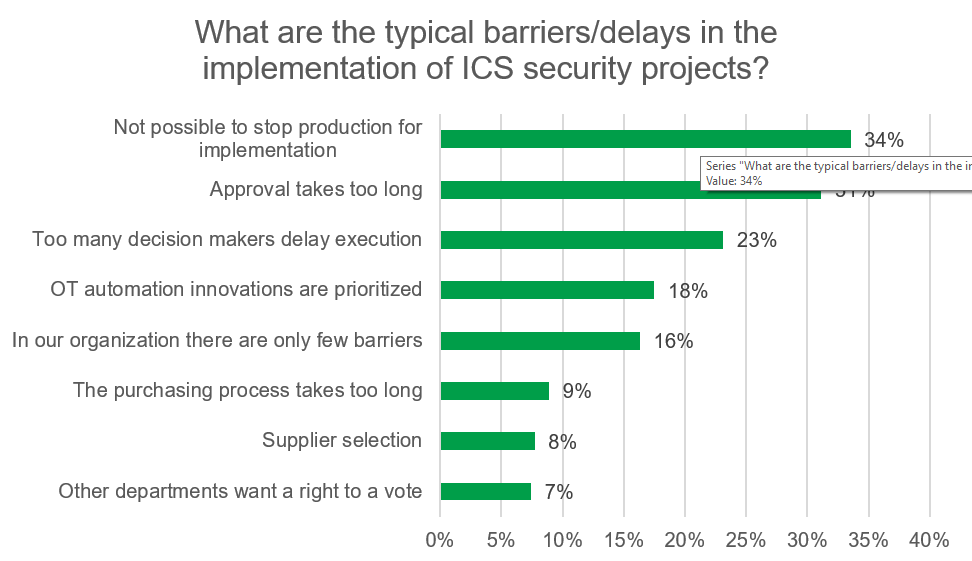The recent Kaspersky report ‘State of Industrial Cybersecurity in the Era of Digitalization’ has revealed the main barriers that inhibit or delay implementation of industrial cybersecurity projects.
Woburn, MA – September 15, 2020 – Today, Kaspersky is sharing a new report that reveals the main barriers that inhibit or delay implementation of industrial cybersecurity projects. The survey results found that the most common obstacles include the inability to stop production (34%), and bureaucratic steps such as a lengthy approval process (31%) and having too many decision-makers (23%). These barriers are becoming more critical due to the ongoing COVID-19 pandemic as they can affect the implementation of pandemic-driven operational technology (OT) security initiatives.
Each year there is an increasing amount of high-profile attacks hitting industrial control systems (ICS). The pandemic lockdown introduced its own set of challenges in addition to the existing threat landscape. Industrial firms had to adapt to new norms including remote work, overnight digitalization and new hygiene requirements, as well as specific pandemic-driven threats such as a massive growth in phishing attacks. As a result, organizations must be sure their protection is up to date and there are no open doors for malicious actions in ICS networks.
Remarkably, survey participants responded that most of the barriers they face when implementing cybersecurity initiatives for ICS environments refer to bureaucratic challenges rather than technical obstacles. In total, almost half of organizations (46%) face red tape delays. In addition to the most prevalent obstacle, long approval times and numerous decision-makers, prolonged supplier selection and purchasing processes, as well as interference from other departments, also proved to be a pain point.

Typical barriers in the implementation of OT/ICS security projects
These barriers may become even more critical in the current post-lockdown period. The survey revealed that almost half of organizations (46%) expect to see changes in their OT security priorities as a result of the pandemic. These organizations will likely need to shift their security strategy at a moment’s notice and quickly implement new cybersecurity practices. Due to the specific requirements of OT, the barriers for implementation can complicate and slow down the process even more. Some organizations will need to be even more conscious as they try to overcome these difficulties with decreased OT security budgets (24%).
“It’s always more difficult to invest money and resources in projects without a clear return on investment, such as with cybersecurity initiatives,” said Georgy Shebuldaev, head of growth center at Kaspersky. “And while cybersecurity for OT is still a developing area, all these management barriers are quite natural. As a vendor, it is up to us to help customers eliminate these obstacles and simplify and speed up the implementation of protection measures. Our task is to make ROI more transparent and showcase the risks for businesses so customers can understand the benefits from the very beginning and better justify them to C-suite or the board if needed.”
In order to help industrial organizations accelerate the implementation of industrial cybersecurity projects, Kaspersky suggests the following steps:
- If an organization doesn’t have enough experience and practice in complex ICS security projects, it’s better to implement solutions step by step. Start with building organizational processes and adopting basic cybersecurity measures such as security gateways and endpoint protection. Then move to more complex projects such as network monitoring, intrusion prevention and SIEM. Industrial standards, such as ISO or IEC guidelines, can help to organize methods and increase the speed of project execution.
- Introduce a practice whereby all new OT systems are implemented with cybersecurity built-in. This should simplify further protection processes and give the OT security team the ability to test new protection tools on these parts of the infrastructure.
- Enable education and training for all teams including specific ICS security training for IT security and OT engineers and awareness to all employees. This will help different teams understand the risks and responsibilities of each other and increase the overall level of consciousness about cybersecurity.
- Choose a reliable cybersecurity solution for OT components and networks, as well as trusted partners for implementation. Kaspersky Industrial CyberSecurity solution includes dedicated protection for endpoints and network monitoring as well as ICS expert services and intelligence. The services enable cybersecurity assessment, incident response and obtaining the latest data about emerging threats and how to address them. The results of cybersecurity assessments may be helpful in justifying protection projects to the board.
To read the full report ‘State of Industrial Cybersecurity in the Era of Digitalization’ please visit the web page. More information about Kaspersky solutions for industrial organizations can be found here.
About Kaspersky
Kaspersky is a global cybersecurity company founded in 1997. Kaspersky’s deep threat intelligence and security expertise is constantly transforming into innovative security solutions and services to protect businesses, critical infrastructure, governments and consumers around the globe. The company’s comprehensive security portfolio includes leading endpoint protection and a number of specialized security solutions and services to fight sophisticated and evolving digital threats. Over 400 million users are protected by Kaspersky technologies and we help 270,000 corporate clients protect what matters most to them. Learn more at usa.kaspersky.com.
Media Contact:
Cassandra Faro
Cassandra.Faro@Kaspersky.com
781-503-1812




